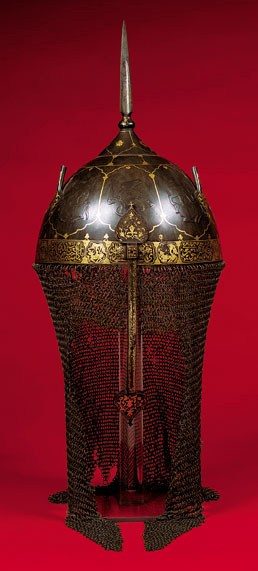"Glory and prosperity" are the first words of a benediction often inscribed on medieval Islamic metalwork, and any civilization that could bear the costs of intricately decorated objects for everyday, secular uses might aptly be characterized as one of glorious prosperity. Thus, Glory and Prosperity: Metalwork of the Islamic World is the title of an exhibition at Harvard's Arthur M. Sackler Museum, through July 21, of 66 objects, most of them from the museum's permanent collection and many never before displayed.
Melanie Michailidis, a Ph.D. candidate in architecture at MIT, curated the exhibition and wrote the accompanying brochure that describes the objects and the techniques by which they were fashioned throughout an immense area and the course of 13 centuries. Here are richly detailed inkwells, daggers, ewers, gauntlets, candlesticks, astrolabes, a fountain spouteven, at the gallery entrance, a flywhisk wrought of silver, gold, enamel, and peacock feathers.
 |
| Who wouldn't like a steel pear with gold overlay? It was made in Iran in the nineteenth century. |
Hoarding vessels of silver and gold, or eating and drinking from them, were prohibited by religious sanction, yet such objects were made. Few survive because when hard times came, they went into the melting pot. Copper alloys were safer, either brass (copper and zinc) or bronze (copper and tin), with brass the more common because tin was not mined abundantly in the Islamic world and had to be imported. (If bronze is at least 20 percent tin, it resembles silver when new, and high-tin bronze was popular in early Islamic Iran.) Beginning in the twelfth century, artisans throughout the Islamic world made brass objects inlaid with silver, gold, and copper, in designs that became ever more elaborate. Steel was used at first for arms and armor, but then for household objects, such as a splendid Iranian nineteenth-century ewer with gold overlay in the exhibition. Finally, artisans produced purely decorative sculptures of steela pigeon, a pair of roosters, or the pear shown here.
 |
| The inscription on this brass vase with silver inlay reveals that it was made for a top-level military person, or great emir, of Sultan Hasan, in Egypt or Syria, lands where Hasan reigned on and off from 1347 to 1361. |
 |
| This twelfth-century lamp from Khurasan in Iran, made of a four-metal alloy, resembles in shape Roman and Byzantine prototypes, but its handle is in the form of a split palmette, one of many vegetal devices found on Islamic metalwork. Below, palmettes scroll profusely across a pen box. |
 |
| Three rows of embattled animals encircle this seventeenth-century, watered-steel helmet from Iran: in gold overlay near the spike, in relief work around the middle, and in gold inlay at the base. Cartouches interspersed in the bottom band contain verses from the Persian national epic, the Shahnama, and the Qur'an. The chain-mail rings are of brass and steel. Watered steel can be made to show various patterns "created by changes in the crystalline structure of the metal during a slow cooling process and forging," curator Michailidis explains. "The pattern is then brought out through acid etching, or the application of a mildly acidic substance such as lemon juice, sour beer, or cow dung." |
 |
| The letters of the Arabic inscription on this pen box, of an utterance ascribed to the Prophet Muhammad, end in human heads, a decorative fancy that was declining in popularity when the box was made in fourteenth-century Iran or Syria. The box is unusual in bearing such intricate decoration on its lid and clasps but being elsewhere plain. "There can be no doubt," writes Michailidis, that a brass pen box such as this one, "with its minutely executed designs in silver and gold inlay, was a luxury object of the highest order." |
Pear, helmet, pen box: Arthur M. Sackler Museum, Michael Nedzweski;>vase: Arthur M. Sackler Museum, Junius Beebe; lamp: Fogg Art Museum, Junius Beebe
All objects © President and Fellows of Harvard College, Harvard University Art Museums





